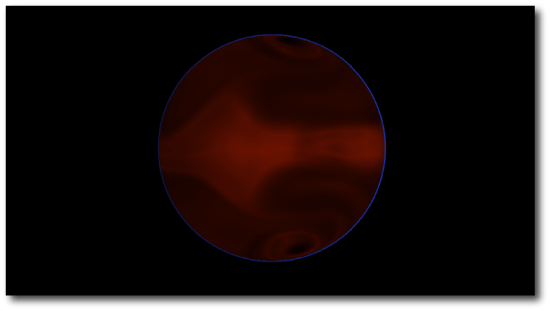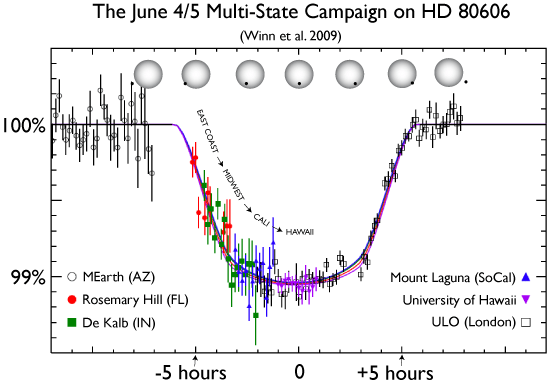
An unsung advantage of long-period transiting planets is that the occultations occur on a civilized timescale. An interval of 111.4357 days is long enough not to feel pressured, rushed, or in constant danger of getting scooped. This is in stark contrast, to, say, managing your affairs with a fixed 2.2185733 day turn-around time.
Earlier this summer, there were two papers, one by Pont et al. and one by Gillon which presented complete, leisurely analyses that combine all of the available photometric and RV data for the HD 80606 system taken through the Valentine’s Day 2009 transit. These papers adopted a fully Bayesian approach to analyzing the heterogeneous data sets, and were able to improve the system’s vital stats: The planet has a radius very similar to Jupiter. The full duration of the transit is close to 12 hours (and uncertain to a bit more than an hour). With high confidence, the planet’s orbit is badly misaligned with the stellar equator — just as expected from the Kozai migration hypothesis.
Last night, Josh Winn sent me a new preprint that reports results from an extensive campaign that he spearheaded to observe the June 4th/5th 2009 transit. June, to put it mildly, is not exactly an ideal time to observe HD 80606 from Earth. The nights in the Northern Hemisphere are short, and the star sets early. At any given spot, you can get at best a few hours of uninterrupted data. Nevertheless, it was of great interest to bag the transit. The ingress was weathered out during the February event, and so the analyses of Pont et al. and Gillon had to lean rather heavily on the Good Reverend Bayes.
Josh’s strategy was to recruit an East-to-West swath of observers in Massachusetts, New Jersey, Florida, Indiana, Texas, Arizona, California, and Hawaii. The idea was that 168 electoral votes would be enough to tilt the contest in favor of the good guys.
The multi-state strategy paid off. By stringing together the individual photometric blocks, the first half of the transit was nicely resolved. At the finish line, on the summit of Mauna Kea, the Keck telescope stepped up to the podium to obtain a series of mid-transit spectroscopic measurements that further confirmed the severe spin-orbit misalignment.

.ppt-ready higher resolution version
This is just the sort of project that underscores the great value of ad-hoc collaborations. The Florida ingress observations, for example, were made using the University of Florida’s recently refurbished Rosemary Hill Observatory, 30 miles from Gainesville. The DeKalb observations, made by Indiana amateur Donn Starkey, produced reduced data that were among the best in the entire aggregate. Mount Laguna Observatory, run by San Diego State University, has generated many cutting-edge exoplanet observations, including critical photometry in the Fall 2007 HD 17156b campaign. The University of Hawaii 2.2m telescope turned out photometry with astonishing rms=0.00031 precision. And as the cherry on top, the simultaneous commandeering of not one but two major telescopes on Mauna Kea? It seems that perhaps someone has made a Faustian bargain.

Looks pretty neat, unfortunately the preprint link doesn’t work.
Hi Andy,
Thanks for the heads-up — I’ve fixed the link.
Greg
Pingback: Blog de Astronomia do astroPT » Novo Trânsito de HD80606b
Pingback: Blog de Astronomia do astroPT » HD 80606b